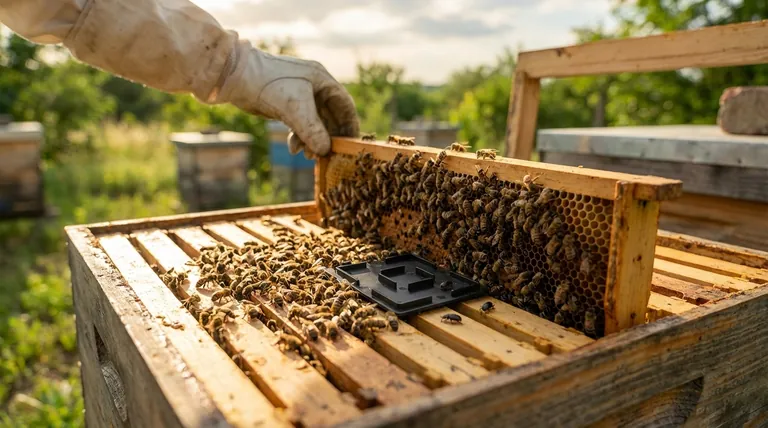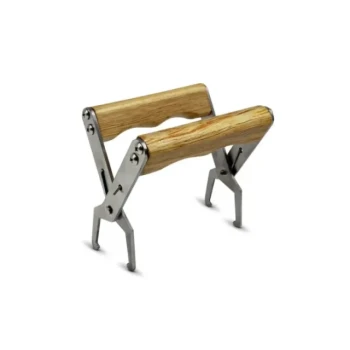In short, the Small Hive Beetle (SHB), or Aethina tumida, is an opportunistic pest that scavenges and reproduces within honey bee colonies. Native to sub-Saharan Africa, these beetles have become a significant problem for beekeepers, particularly in warmer, humid climates like the southern United States. While adult beetles cause some stress, the destructive larval stage is responsible for contaminating honey, destroying comb, and potentially causing the entire colony to collapse or abscond.
The core problem isn't the beetle itself, but what it represents. A Small Hive Beetle infestation is less a cause of colony failure and more a symptom of an underlying weakness or imbalance that the beetles exploit with devastating speed.

The Beetle's Lifecycle: From Intruder to Infestation
Understanding how the Small Hive Beetle operates is the first step toward managing it. The beetle's life cycle is specifically adapted to take advantage of the beehive environment.
The Adult Beetle Infiltration
Adult beetles are small, dark, and adept at entering hives. They often hide in cracks and crevices, avoiding the bees. A key behavior is tricking guard bees into feeding them, allowing them to survive and lay eggs inside the hive.
The Larval Stage: The Source of Destruction
Female beetles lay their eggs in clusters, often hidden in comb or cracks. Once these eggs hatch, the larvae begin to tunnel through the honeycomb. They consume honey, pollen, and bee brood indiscriminately.
As they feed, the larvae defecate in the honey, introducing yeast that causes the honey to ferment and run out of the cells. This creates a foul-smelling, slimy mess that can coat the frames.
Pupation in the Soil
After about one to two weeks of feeding, mature larvae crawl out of the hive and burrow into the surrounding soil to pupate. This is a critical vulnerability. They thrive in damp, moist soil, which is why apiary ground conditions are a key management factor. After several weeks, they emerge as adult beetles ready to re-infest the same hive or seek out new ones.
How SHB Overwhelm a Honey Bee Colony
A few beetles in a strong, healthy hive are merely a nuisance that the bees can manage. The real danger occurs when the beetle population explodes, overwhelming the colony's defenses.
Creating a "Slime Out"
The combination of fermenting honey and larval waste creates a substance often called "slime." This slime can cover entire frames, ruining honey stores and killing any bee brood it touches. This is known as a "slime out," and it is often an unrecoverable situation.
Forcing the Bees to Abscond
A heavily slimed hive is no longer a viable home for honey bees. The foul odor and contaminated resources will often cause the entire colony to abscond, abandoning the hive and its contents completely. This is the ultimate consequence of a failed SHB infestation.
Stressing the Colony's Defenses
Even before a full-blown slime out, a rising beetle population forces the bees to divert resources. Worker bees must spend valuable time and energy corralling adult beetles into "prisons" made of propolis instead of foraging, tending to the queen, or raising brood.
Common Management Pitfalls to Avoid
Controlling Small Hive Beetles is about proactive management and understanding their weaknesses, not just reacting to an infestation.
Ignoring Colony Strength
The single biggest mistake is failing to maintain strong, populous colonies. A weak hive with a low bee-to-comb ratio cannot effectively patrol its territory, leaving empty spaces for beetles to lay eggs uncontested. SHB are a weak colony problem.
Providing a Favorable Environment
As noted, SHB larvae require moist soil to pupate. Placing hives in constantly damp, shady areas or allowing dense weeds to grow around the hive entrance creates an ideal breeding ground right at the colony's doorstep.
Delaying Honey Extraction
Leaving full honey supers on a hive for too long, especially on a weaker colony, provides a massive food source for beetle larvae. A "slimed out" honey super is a complete loss and a major setback for the hive.
How to Apply This to Your Apiary
Your management strategy should be tailored to the state of your colonies and your primary goals for the season.
- If your primary focus is prevention in strong hives: Ensure the ground around your hives is well-drained and exposed to sunlight, and use in-hive traps as a monitoring tool.
- If your primary focus is supporting a weaker colony: Reduce the hive's interior space to what the bees can actively defend, and consider supplementing their feed to boost population growth quickly.
- If your primary focus is dealing with a confirmed infestation: Immediately remove and freeze any slimed frames to kill larvae, and install aggressive in-hive traps to reduce the adult beetle population.
Ultimately, managing Small Hive Beetles is a fundamental part of responsible beekeeping that reinforces the most important principle: a strong, healthy, and well-managed colony is its own best defense.
Summary Table:
| Stage | Key Impact | Management Focus |
|---|---|---|
| Adult Beetle | Infiltrates hive, stresses bees, lays eggs. | Use in-hive traps for monitoring and control. |
| Larva | Tunnels through comb, contaminates honey ('slime out'). | Remove/freeze affected frames; maintain strong colonies. |
| Pupa | Develops in moist soil near hive. | Keep apiary ground dry and sunny to disrupt lifecycle. |
Protect Your Apiary with Professional-Grade Equipment
Is your operation at risk from Small Hive Beetles? A strong, well-equipped hive is its own best defense. HONESTBEE supplies commercial apiaries and beekeeping equipment distributors with the durable, high-quality supplies needed to maintain healthy, robust colonies that can withstand pest pressures.
From hive components to monitoring tools, our wholesale-focused operations ensure you get the reliable equipment your business depends on.
Contact HONESTBEE today to discuss your wholesale supply needs and fortify your hives against destructive pests.
Visual Guide

Related Products
- Black Plastic Beetle Barn Hive Beetle Trap for Beehives
- Reusable Clear Small Hive Beetle Traps for Beehives Beetle Trapping Tools
- Removable Washable Hive Beetle Trap Attractants for Small Hive Beetles
- Plastic Beetle Blaster Trap Beekeeping Tools and Supplies
- Wholesales Dadant Size Wooden Bee Hives for Beekeeping
People Also Ask
- How should filled beetle traps be handled? Safely Remove and Dispose to Protect Your Hive
- How should beetle traps be placed in the hive? Achieve Perfect Flush Placement for Maximum Control
- What are the steps for installing hive beetle traps? A Guide to Effective Beetle Control
- What tips can help prevent hive beetle infestations? Build Strong Colonies & Master Apiary Hygiene
- What is the recommended number of beetle traps per hive? Optimize Your Hive's Beetle Defense



















